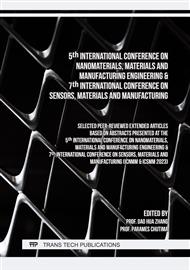p.3
p.9
p.15
p.21
p.29
p.37
p.43
p.53
Green Synthesis of Magnetite Nanoparticles Using Moringa oleifera and their Electro-Optic Surface Plasmon Resonance Properties
Abstract:
The application of an external electric field to the surface plasmon resonance (SPR) system of green-synthesized magnetite (Fe3O4) nanoparticles (MNPs) is very promising for increasing the SPR detection signal. Electro-optic surface plasmon resonance (EOSPR) behavior of MNPs has been successfully carried out. The EOSPR system was investigated using the Kretschmann configuration with the prism/Au thin film/MNPs/air layer arrangement and applying an electric voltage of 0 V, 2 V, 4 V, and 6 V. In this study, we synthesized MNPs using the green synthesis approach from moringa oleifera extract. The benefits of green synthesis include being safe, affordable, clean, and ecologically friendly processes. X-ray diffraction results obtained crystal size of the MNPs is about 9.2 nm with inverse spinel face-centered cubic crystal structure. Fourier transforms infrared characterization showed the presence of Fe-O bonds at wave numbers 569 cm-1 and 629 cm-1, indicating that MNPs were successfully formed. The saturation magnetization of the samples is 55.3 emu/g. The SPR angle of the SPR system Prism/Au thin film/air without the addition of MNPs is 44.66°. After being deposited by MNPs and induced by a voltage of 0 V, 2 V, 4 V, and 6 V, the SPR angles changed to 44.87°, 44.90°, 44.95° and 45.12°. The addition of MNPs and an external electric field causes the SPR angle to increase. The results of this study can provide new insights into the development of optical devices that can be manipulated electrically and have the potential for future biosensor applications.
Info:
Periodical:
Pages:
21-26
Citation:
Online since:
February 2024
Price:
Сopyright:
© 2024 Trans Tech Publications Ltd. All Rights Reserved
Share:
Citation:



